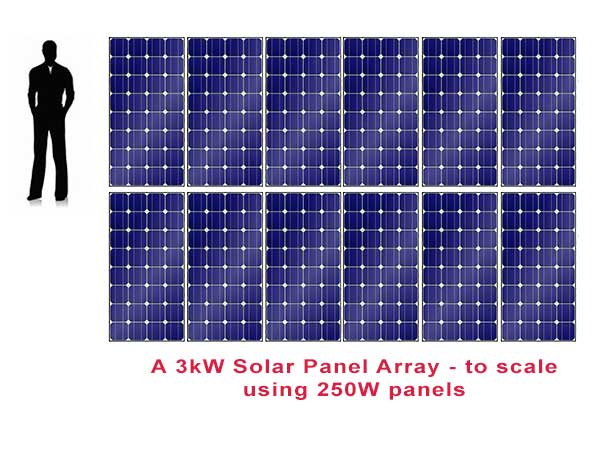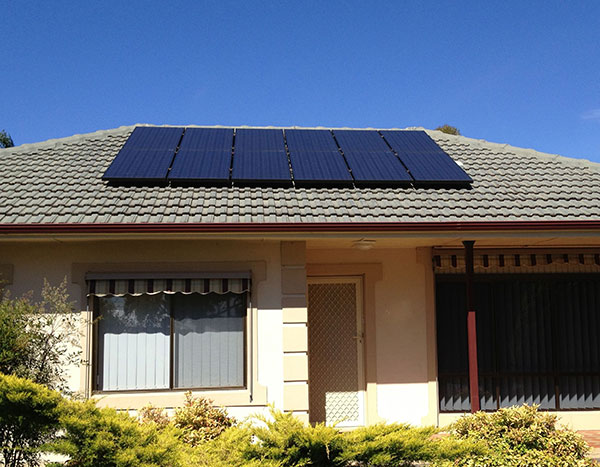3kW Solar System
Last Updated: 1st Jan 2025
A 3kW solar system was once the most popular sized residential solar system in the country, but times have changed and most households choose a much larger system – 6.6kW or, even better, 10kW or more; as solar prices have dropped considerably over recent years.
You can pick up a good 3kW system, installed for about $3,500-$5,000 (Jan 2025).
While you can purchase up a crap one for $3,000, I would not recommend buying the cheapest system on the market.
For an average Aussie home, a 3kW solar system will generate the equivalent of about two-thirds of total electricity usage. But be warned; if you have ducted air-con, a pool pump, and a couple of fridges in your big ol’ house, then it won’t make much of a dent in your electricity bills!
How many solar panels will you need?
To make up a 3kW solar system you needed 12 solar panels, assuming that you use 250W panels – but these days much more powerful panels are used; around 415W.
Each 250W panel was approximately 1.6m x 1m, so you needed at least 20 square metres of roof space.
To give you a feel for how big 20 square metres is this picture may help
And here’s what one looks like on a roof:
These days, solar panels are often 415W or larger, so only around 7 are required for a 3kW solar system:
How much electricity will a 3kW solar system generate?
A 3kW solar power system will generate approximately 12 units of electricity (called kilowatt-hours or kWh‘s) per day. As mentioned, this is about 2/3 of the electricity usage of a modest Australian home.
How much cash will a 3kW solar system earn?
The amount of money you save with a 3kW system will depend on 2 main factors:
1) When you use the electricity in your home
2) How much much electricity you use.
In fact, (1) is usually a bigger factor than (2). Why? Because the timing determines how much of your precious solar energy goes out into the grid instead of into your home.
This matters because households receive around 5c – 8c per kWh for exported electricity. Compare that with the 30c per kWh most folks pay to buy electricity from the grid. This means that using your solar electricity energy in your home saves you 30c per kWh, whereas exporting may only earn you 8c per kWh. A 350% difference!
Let’s consider 3 scenarios to see how the payback works:
Scenario 1) You use all your solar electricity in your home. This is unlikely unless your home is full of energy guzzling appliances (e.g. ducted air con and/or big pool pumps) that run through the middle of the day, every day. But in this scenario you would save 30c per kWh for every last drop of solar energy you produce, which equates to approximately $1300 in the first year and about $26,000 over 20 years.
Scenario 2) You export half your solar electricity and use half in your home. This is a more realistic scenario for most folks. In this case You would save about $830 in the first year. And about $16,600 over 20 years.
Scenario 3) You use no power in your home when the sun is shining (unlikely). In this scenario, you export all your solar electricity. In this case, with an 8 cent feed-in tariff, you would save about $350 in the first year, and about $7,000 over 20 years.
As you can see, solar can give a great return in Scenario 1 and 2, but is pretty marginal in Scenario 3. So it is important to get quotes from installers who can estimate your export percentage.
If you are intrigued by the whole import/export thing, then you can read about the relationship between exports and payback here.
You can see the payback and cash-flow numbers for yourself with my solar payback calculator.
How much will a 3kW solar system cost?
At current pricing, you can expect to pay about $3,500-$5,000 for a good 3kW solar system installed on your roof. This is for a system with quality components, installed by an experienced professional.
How long before a 3kW solar power system pays for itself?
If you are not exporting any energy then it will pay back in less than 3 years, assuming you pay 30c per kWh for imported electricity. The more energy you export the longer that stretches out. But the great thing about solar (that can be lost in a simple payback calculation) is this: The monthly cash flows to get your payback can be positive, for many people (depending on how you pay for the system).
This means that there is a good chance that – from the first month – your savings will be greater than the cost of financing the system (or if you are paying cash your savings will be more than the interest you would have earned from the $4,000 sitting in the bank).
So I hope I don’t come across as a slimy salesman by pointing out that you may be leaving cash on the table every month you don’t have solar on your roof.
Again – this all depends on your individual situation – so if you are keen to explore reducing your overheads with solar energy, I recommend getting 3 quotes from hand-picked, local installers who can work out if solar makes financial sense for you or not.


